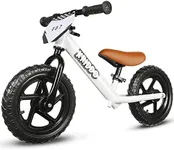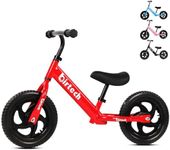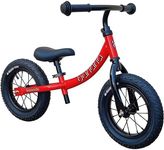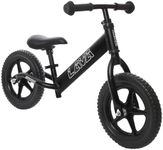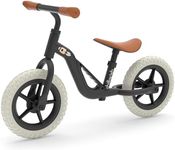Buying Guide for the Best Balance Bike For Toddlers
Choosing the right balance bike for your toddler can be a fun and rewarding experience. Balance bikes are designed to help young children learn how to balance and steer before they transition to a pedal bike. When selecting a balance bike, it's important to consider several key specifications to ensure it meets your child's needs and provides a safe and enjoyable riding experience.SizeThe size of the balance bike is crucial because it needs to fit your child properly. Balance bikes come in various sizes, typically measured by the wheel diameter, ranging from 10 to 14 inches. A bike that is too big or too small can be difficult for your child to handle. To find the right size, measure your child's inseam and compare it to the bike's seat height. The seat height should be about 1 inch less than your child's inseam to allow them to comfortably touch the ground with their feet.
WeightThe weight of the balance bike is important because a lighter bike is easier for a toddler to maneuver and control. Balance bikes generally weigh between 5 to 10 pounds. For younger or smaller children, a lighter bike is preferable as it will be less cumbersome and more manageable. As your child grows and becomes more confident, they may be able to handle a slightly heavier bike.
Frame MaterialBalance bikes are made from various materials, including wood, metal, and plastic. Wooden bikes are eco-friendly and have a classic look, but they may not be as durable as metal bikes. Metal bikes, typically made from aluminum or steel, are sturdy and long-lasting. Plastic bikes are lightweight and often more affordable, but they may not be as durable as metal options. Consider your priorities, such as durability, weight, and aesthetics, when choosing the frame material.
AdjustabilityAdjustability refers to the ability to change the height of the seat and handlebars. This feature is important because it allows the bike to grow with your child, providing a longer period of use. Look for bikes with easily adjustable seats and handlebars to ensure a comfortable fit as your child grows. Some bikes offer tool-free adjustments, which can be convenient for parents.
TiresBalance bike tires come in different types, including air-filled (pneumatic) tires, foam tires, and solid rubber tires. Air-filled tires provide better traction and a smoother ride, especially on uneven surfaces, but they require maintenance to keep them inflated. Foam tires are lightweight and maintenance-free but may not offer as much cushioning. Solid rubber tires are durable and maintenance-free but can be heavier. Consider where your child will be riding the bike and choose the tire type that best suits those conditions.
BrakesSome balance bikes come with hand brakes, while others do not. Hand brakes can be a useful feature for older toddlers who are ready to learn how to use them, providing an additional level of safety. However, younger children may find it easier to stop the bike using their feet. If you choose a bike with brakes, ensure they are easy for your child to reach and operate.
FootrestsFootrests are small platforms where your child can place their feet while gliding on the balance bike. They can help your child practice balancing without pedaling. Some bikes have built-in footrests, while others do not. If your child is just starting out, footrests may not be necessary, but they can be a nice feature as your child becomes more confident and skilled.
